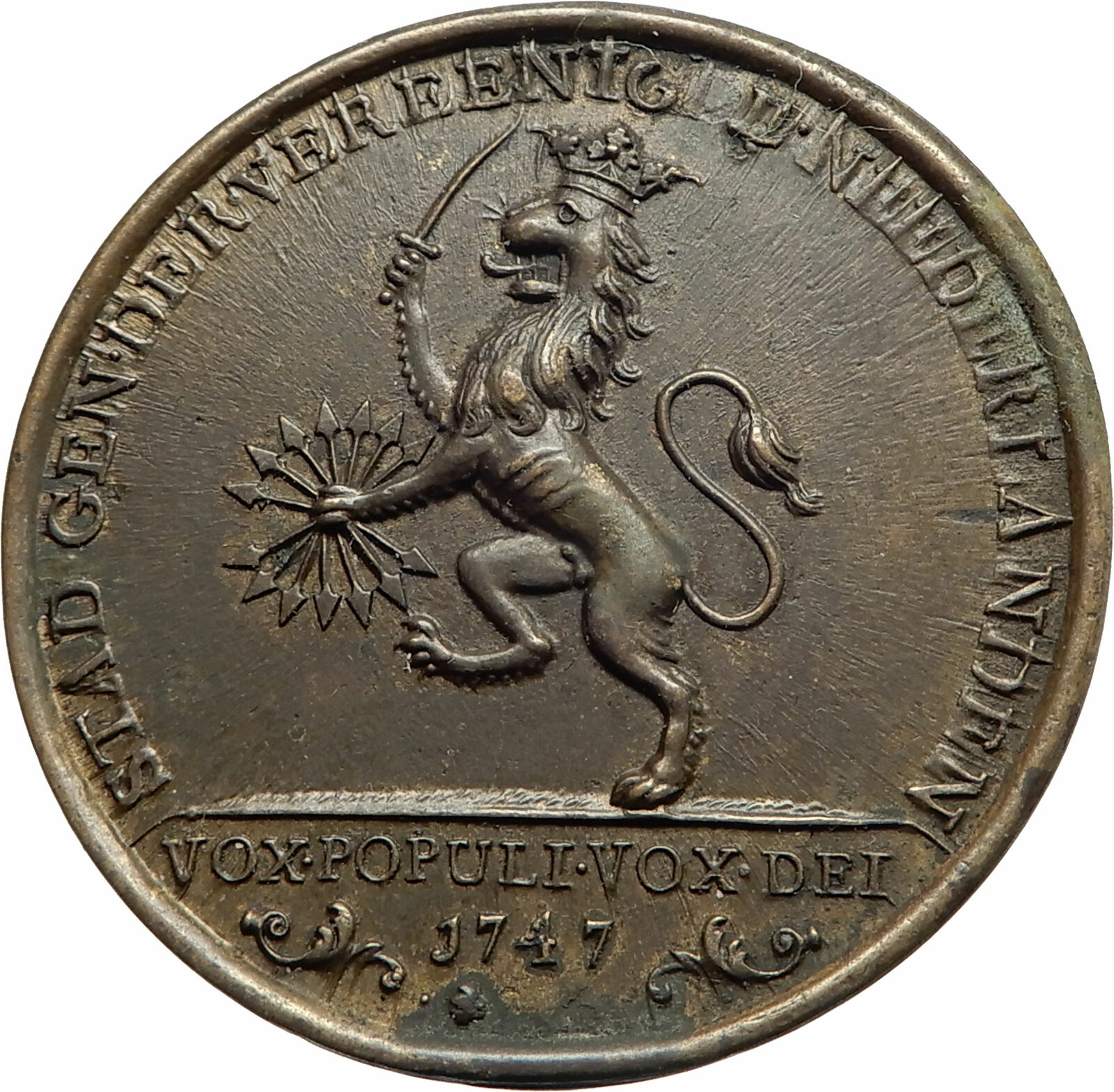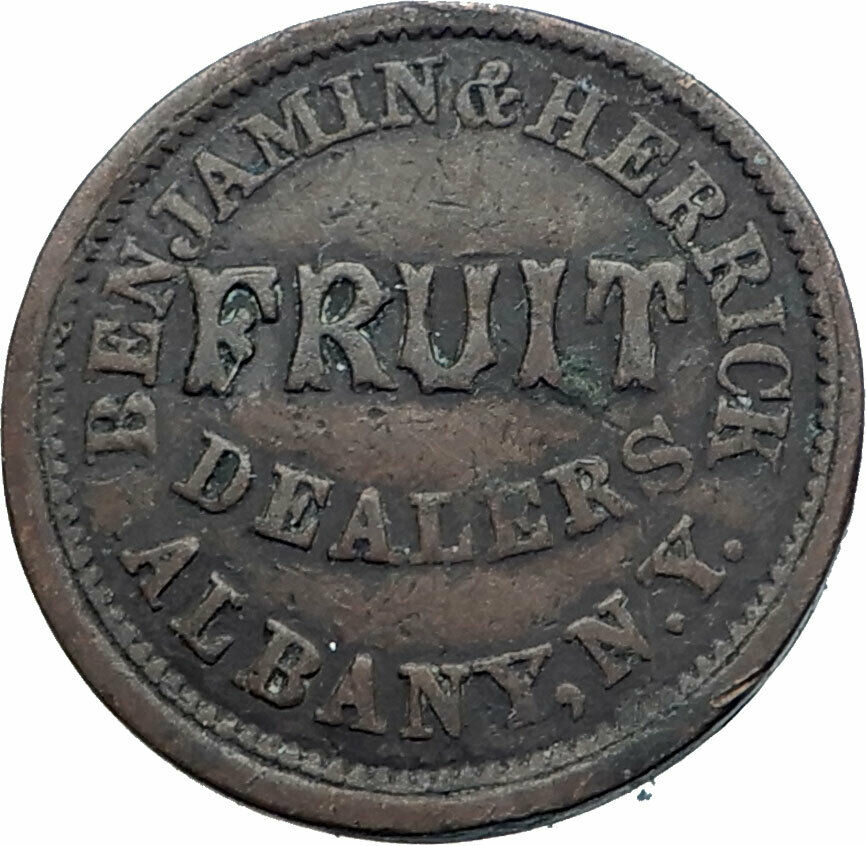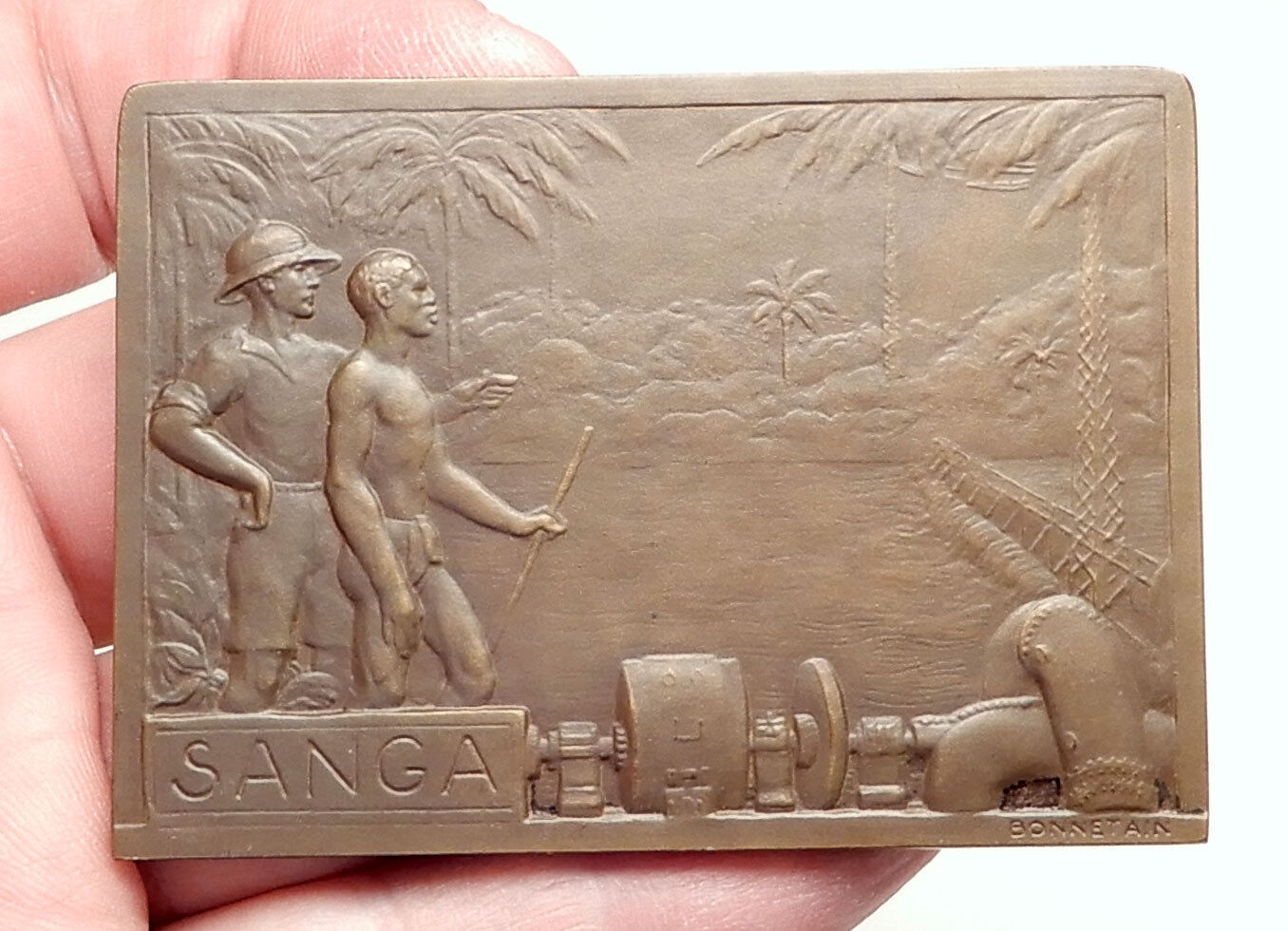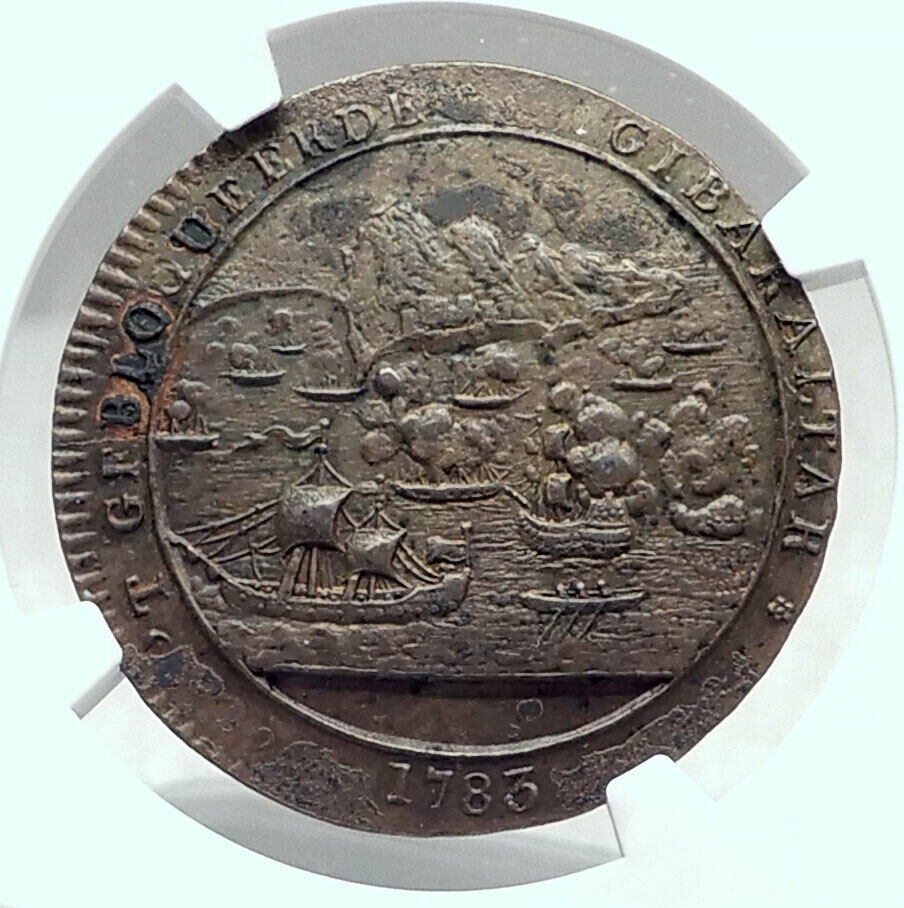|
France – Siege of Paris
1870-1871 Silver Medal 50mm (67.8 grams) by C. Degeorge
Woman seated atop cannon receiving a flying pigeon; balloon in background; PARIS 1870-1871 below.
MINISTERE DE LA GUERRE CONCOURS DE L’ETAT, Pigeon next atop wall with many pigeons flying around.
Balloon mail was the only means by which communications from the besieged city could reach the rest of France. Likely the messenger pigeons were the second means of communication, along with being a symbol of peace.
You are bidding on the exact item pictured, provided with a Certificate of Authenticity and Lifetime Guarantee of Authenticity.
The Siege of Paris, lasting from 19 September 1870 to 28 January 1871, and the consequent capture of the city by Prussian forces, led to French defeat in the Franco-Prussian War and the establishment of the German Empire as well as the Paris Commune.
As early as August 1870, the Prussian 3rd Army led by Crown Prince Frederick of Prussia (the future Emperor Frederick III), had been marching towards Paris. The army was recalled to deal with French forces accompanied by Napoleon III. These forces were crushed at the Battle of Sedan, and the road to Paris was left open. Personally leading the Prussian forces, King William I of Prussia, along with his chief of staff Helmuth von Moltke, took the 3rd Army and the new Prussian Army of the Meuse under Crown Prince Albert of Saxony, and marched on Paris virtually unopposed. In Paris, the Governor and commander-in-chief of the city’s defenses, General Louis Jules Trochu, assembled a force of 60,000 regular soldiers who had managed to escape from Sedan under Joseph Vinoy or who were gathered from depot troops. Together with 90,000 Mobiles (Territorials), a brigade of 13,000 naval seamen and 350,000 National Guards, the potential defenders of Paris totalled around 513,000 personnel. The compulsorily enrolled National Guards were, however, untrained.
Siege
The Prussian armies quickly reached Paris, and on 15 September Moltke issued orders for the investment of the city. Crown Prince Albert’s army closed in on Paris from the north unopposed, while Crown Prince Frederick moved in from the south. On 17 September a force under Vinoy attacked Frederick’s army near Villeneuve-Saint-Georges in an effort to save a supply depot there, but it was eventually driven back by artillery fire. The railroad to Orléans was cut, and on the 18th Versailles was taken, and then served as the 3rd Army’s and eventually Wilhelm’s headquarters. By 19 September the encirclement was complete, and the siege officially began. Responsible for the direction of the siege was General (later Field Marshal) von Blumenthal.
Prussia’s chancellor Otto von Bismarck suggested shelling Paris to ensure the city’s quick surrender and render all French efforts to free the city pointless, but the German high command, headed by the king of Prussia, turned down the proposal on the insistence of General von Blumenthal, on the grounds that a bombardment would affect civilians, violate the rules of engagement, and turn the opinion of third parties against the Germans, without speeding up the final victory. It was also contended that a quick French surrender would leave the new French armies undefeated and allow France to renew the war shortly after. The new French armies would have to be annihilated first, and Paris would have to be starved into surrender.
Trochu had little faith in the ability of the National Guards, which made up half the force defending the city. So instead of making any significant attempt to prevent the investment by the Germans, Trochu hoped that Moltke would attempt to take the city by storm, and the French could then rely on the city’s defenses. These consisted of the 33 km (21 mi) Thiers wall and a ring of sixteen detached forts, all of which had been built in the 1840s.[2] Moltke never had any intention of attacking the city and this became clear shortly after the siege began. Trochu changed his plan and allowed Vinoy to make a demonstration against the Prussians west of the Seine. On 30 September Vinoy attacked Chevilly with 20,000 soldiers and was soundly repulsed by the 3rd Army. Then on 13 October the II Bavarian Corps was driven from Châtillon but the French were forced to retire in face of Prussian artillery.
General Carey de Bellemare commanded the strongest fortress north of Paris at Saint Denis. On 29 October de Bellemare attacked the Prussian Guard at Le Bourget without orders, and took the town. The Guard actually had little interest in recapturing their positions at Le Bourget, but Crown Prince Albert ordered the city retaken anyway. In the battle of Le Bourget the Prussian Guards succeeded in retaking the city and captured 1,200 French soldiers. Upon hearing of the French surrender at Metz and the defeat at Le Bourget, morale in Paris began to sink. The people of Paris were beginning to suffer from the effects of the German blockade. Hoping to boost morale Trochu launched the largest attack from Paris on November 30 even though he had little hope of achieving a breakthrough. Nevertheless, he sent Auguste-Alexandre Ducrot with 80,000 soldiers against the Prussians at Champigny, Créteil and Villiers. In what became known as the battle of Villiers the French succeeded in capturing and holding a position at Créteil and Champigny. By 2 December the Württemberg Corps had driven Ducrot back into the defenses and the battle was over by 3 December.
On 19 January a final breakout attempt was aimed at the Château of Buzenval in Rueil-Malmaison near the Prussian Headquarters, west of Paris. The Crown Prince easily repulsed the attack inflicting over 4,000 casualties while suffering just over 600. Trochu resigned as governor and left General Joseph Vinoy with 146,000 defenders.
During the winter, tensions began to arise in the Prussian high command. Field-Marshal Helmuth von Moltke and General Leonhard, Count von Blumenthal who commanded the siege (seen in the illustration on this page behind Bismarck’s right shoulder) were primarily concerned with a methodical siege that would destroy the detached forts around the city and slowly strangle the defending forces with a minimum of German casualties.
But as time wore on, there was growing concern that a prolonged war was placing too much strain on the German economy and that an extended siege would convince the French Government of National Defense that Prussia could still be beaten. A prolonged campaign would also allow France time to reconstitute a new army and convince neutral powers to enter the war against Prussia. To Bismarck, Paris was the key to breaking the power of the intransigent republican leaders of France, ending the war in a timely manner, and securing peace terms favourable to Prussia. Moltke was also worried that insufficient winter supplies were reaching the German armies investing the city, as diseases such as tuberculosis were breaking out amongst the besieging soldiers. In addition, the siege operations competed with the demands of the ongoing Loire Campaign against the remaining French field armies.
In January, on Bismarck’s advice, the Germans fired some 12,000 shells into the city over 23 nights in an attempt to break Parisian morale. About 400 perished or were wounded by the bombardment which, “had little effect on the spirit of resistance in Paris.”[3] Delescluze declared, “The Frenchmen of 1870 are the sons of those Gauls for whom battles were holidays.” Due to a severe shortage of food, Parisians were forced to slaughter whatever animals were at hand. Rats, dogs, cats, and horses were the first to be slaughtered and became regular fare on restaurant menus. Once the supply of those animals ran low, the citizens of Paris turned on the zoo animals residing at Jardin des plantes. Even Castor and Pollux, the only pair of elephants in Paris, were slaughtered for their meat.
A Latin Quarter menu contemporary with the siege reads in part:
* Consommé de cheval au millet. (horse)* Brochettes de foie de chien à la maître d’hôtel. (dog)* Emincé de rable de chat. Sauce mayonnaise. (cat)* Epaules et filets de chien braisés. Sauce aux tomates. (dog)* Civet de chat aux champignons. (cat)* Côtelettes de chien aux petits pois. (dog)* Salamis de rats. Sauce Robert. (rats)* Gigots de chien flanqués de ratons. Sauce poivrade. (dog, rats)* Begonias au jus. (flowers)* Plum-pudding au rhum et à la Moelle de Cheval. (horse)
Air medical transport is often stated to have first occurred in 1870 during the Siege of Paris when 160 wounded French soldiers were evacuated from the city by hot-air balloon, but this myth has been definitively disproven by full review of the crew and passenger records of each balloon which left Paris during the siege.[4]
During the siege, the only head of diplomatic mission from a major power who remained in Paris was United States Minister to France, Elihu B. Washburne. As a representative of a neutral country, Washburne was able to play a unique role in the conflict, becoming one of the few channels of communication into and out of the city for much of the siege. He also led the way in providing humanitarian relief to foreign nationals, including ethnic Germans.
On 25 January 1871, Wilhelm I overruled Moltke and ordered the field-marshal to consult with Bismarck for all future operations. Bismarck immediately ordered the city to be bombarded with large-caliber Krupp siege guns. This prompted the city’s surrender on 28 January 1871. Paris sustained more damage in the 1870-1871 siege than in any other conflict.
Armistice and surrender
Secret armistice discussions began on January 23, 1871 and continued at Versailles between Jules Favre and Bismarck until the 27th. On the French side there was concern that the National Guard would rebel when news of the capitulation became public. Bismarck’s advice was “provoke an uprising then while you still have an army to suppress it with”. The final terms agreed on were that the French regular troops (less one division) would be disarmed, Paris would pay an indemnity of two hundred million francs, and the fortifications around the perimeter of the city would be surrendered. In return the armistice was extended until February 19.
Food supplies from the provinces, as well as shiploads from Britain and the United States, began to enter the starving city almost immediately. Thirty thousand Prussian, Bavarian and Saxon troops held a brief victory parade in Paris on March 1, 1871 and Bismarck honored the armistice by sending train-loads of food into the city. The German troops departed after two days, to take up temporary encampments to the east of the city; to be withdrawn from there as well as soon as France paid the agreed war indemnity. While Parisians scrubbed the streets “polluted” by the triumphal entry no serious incidents occurred during the short and symbolic occupation of the city. This was in part because the Germans had avoided entry into areas such as Belleville, where hostility was reportedly high.
Air mail
Balloon mail was the only means by which communications from the besieged city could reach the rest of France. The use of balloons to carry mail was first proposed by the photographer and balloonist Felix Nadar, who had established the grandiosely titled No. 1 Compagnie des Aérostatiers, with a single balloon, the Neptune, at its disposal, to perform tethered ascents for observation purposes. However the Prussian encirclement of the city made this pointless, and on 17 September Nadar wrote to the Council for the Defence of Paris proposing the use of balloons for communication with the outside world: a similar proposal had also been made by the balloonist Eugène Godard.
The first balloon launch was carried out on 23 September, using the Neptune, and carried 125 kg (276 lb) of mail in addition to the pilot. After a three-hour flight it landed at Craconville 83 km (52 mi) from Paris. Following this success a regular mail service was established, with a rate of 20 centimes per letter. Two workshops to manufacture balloons were set up, one under the direction of Nadar in the Elysềe-Montmartre dance-hall (later moved to the Gare du Nord), and the other under the direction of Godard in the Gare d’Orleans. Around 66 balloon flights were made, including one that accidentally set a world distance record by ending up in Norway. The vast majority of these succeeded: only five were captured by the Prussians, and three went missing, presumably coming down in the Atlantic or Irish Sea. The number of letters carried has been estimated at around 2.5 million.
Some balloons also carried passengers in addition to the cargo of mail, most notably Léon Gambetta, the minister for War in the new government, who was flown out of Paris on 7 October. The balloons also carried homing pigeons out of Paris to be used for a pigeon post. This was the only means by which communications from the rest of France could reach the besieged city. A specially laid telegraph cable on the bed of the Seine had been discovered and cut by the Prussians on 27 September, couriers attempting to make their way through the German lines were almost all intercepted and although other methods were tried including attempts to use balloons, dogs and message canisters floated down the Seine, these were all unsuccessful. The pigeons were taken to their base, first at Tours and later at Poitiers, and when they had been fed and rested were ready for the return journey. Tours lies some 200 km (120 mi) from Paris and Poitiers some 300 km (190 mi) distant. Before release, they were loaded with their dispatches. Initially the pigeon post was only used for official communications but on 4 November the government announced that members of the public could send messages, these being limited to twenty words at a charge of 50 centimes per word.
These were then copied onto sheets of cardboard and photographed by a M. Barreswille, a photographer based in Tours. Each sheet contained 150 messages and was reproduced as a print about 40 by 55 mm (1.6 by 2.2 in) in size: each pigeon could carry nine of these. The photographic process was further refined by René Dagron to allow more to be carried: Dagron, with his equipment, was flown out of Paris on 12 November in the aptly named Niépce, narrowly escaping capture by the Prussians. The photographic process allowed multiple copies of the messages to be sent, so that although only 57 of the 360 pigeons released reached Paris more than 60,000 of the 95,000 messages sent were delivered. (some sources give a considerably higher figure of around 150,000 official and 1 million private communications, but this figure is arrived at by counting all copies of each message.)
Aftermath
After the Prussians victory Wilhelm I was proclaimed German Emperor on 18 January 1871 at the Palace of Versailles. The kingdoms of Bavaria, Württemberg, and Saxony, the states of Baden and Hesse, and the free cities of Hamburg and Bremen were unified with the North German Confederation to create the German Empire. The preliminary peace treaty was signed at Versailles, and the final peace treaty, the Treaty of Frankfurt, was signed on 10 May 1871. Otto von Bismarck was able to secure Alsace-Lorraine as part of the German Empire.
The continued presence of German troops outside the city angered Parisians. Further resentment arose against the French government, and in March 1871 Parisian workers and members of the National Guard rebelled and established the Paris Commune, a radical and socialist government, which lasted through late May of that year.
  France, officially the French Republic (French: République française), is a sovereign state comprising territory in western Europe and several overseas regions and territories. The European part of France, called Metropolitan France, extends from the Mediterranean Sea to the English Channel and the North Sea, and from the Rhine to the Atlantic Ocean. France spans 640,679 square kilometres (247,368 sq mi) and has a total population of 67 million. It is a unitary semi-presidential republic with the capital in Paris, the country’s largest city and main cultural and commercial centre. The Constitution of France establishes the state as secular and democratic, with its sovereignty derived from the people. France, officially the French Republic (French: République française), is a sovereign state comprising territory in western Europe and several overseas regions and territories. The European part of France, called Metropolitan France, extends from the Mediterranean Sea to the English Channel and the North Sea, and from the Rhine to the Atlantic Ocean. France spans 640,679 square kilometres (247,368 sq mi) and has a total population of 67 million. It is a unitary semi-presidential republic with the capital in Paris, the country’s largest city and main cultural and commercial centre. The Constitution of France establishes the state as secular and democratic, with its sovereignty derived from the people.
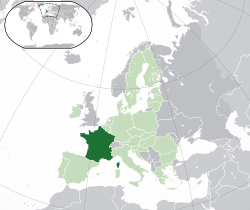
During the Iron Age, what is now Metropolitan France was inhabited by the Gauls, a Celtic people. The Gauls were conquered in 51 BC by the Roman Empire, which held Gaul until 486. The Gallo-Romans faced raids and migration from the Germanic Franks, who dominated the region for hundreds of years, eventually creating the medieval Kingdom of France. France emerged as a major European power in the Late Middle Ages, with its victory in the Hundred Years’ War (1337 to 1453) strengthening French state-building and paving the way for a future centralized absolute monarchy. During the Renaissance, France experienced a vast cultural development and established the beginning of a global colonial empire. The 16th century was dominated by religious civil wars between Catholics and Protestants (Huguenots).
France became Europe’s dominant cultural, political, and military power under Louis XIV. French philosophers played a key role in the Age of Enlightenment during the 18th century. In 1778, France became the first and the main ally of the new United States in the American Revolutionary War. In the late 18th century, the absolute monarchy was overthrown in the French Revolution. Among its legacies was the Declaration of the Rights of Man and of the Citizen, one of the earliest documents on human rights, which expresses the nation’s ideals to this day. France became one of modern history’s earliest republics until Napoleon took power and launched the First French Empire in 1804. Fighting against a complex set of coalitions during the Napoleonic Wars, he dominated European affairs for over a decade and had a long-lasting impact on Western culture. Following the collapse of the Empire, France endured a tumultuous succession of governments: the monarchy was restored, it was replaced in 1830 by a constitutional monarchy, then briefly by a Second Republic, and then by a Second Empire, until a more lasting French Third Republic was established in 1870. By the 1905 law, France adopted a strict form of secularism, called laïcité, which has become an important federative principle in the modern French society.
France reached its territorial height during the 19th and early 20th centuries, when it ultimately possessed the second-largest colonial empire in the world. In World War I, France was one of the main winners as part of the Triple Entente alliance fighting against the Central Powers. France was also one of the Allied Powers in World War II, but came under occupation by the Axis Powers in 1940. Following liberation in 1944, a Fourth Republic was established and later dissolved in the course of the Algerian War. The Fifth Republic, led by Charles de Gaulle, was formed in 1958 and remains to this day. Following World War II, most of the empire became decolonized.
Throughout its long history, France has been a leading global center of culture, making significant contributions to art, science, and philosophy. It hosts Europe’s third-largest number of cultural UNESCO World Heritage Sites (after Italy and Spain) and receives around 83 million foreign tourists annually, the most of any country in the world. France remains a great power with significant cultural, economic, military, and political influence. It is a developed country with the world’s sixth-largest economy by nominal GDP and eight-largest by purchasing power parity. According to Credit Suisse, France is the fourth wealthiest nation in the world in terms of aggregate household wealth. It also possesses the world’s second-largest exclusive economic zone (EEZ), covering 11,035,000 square kilometres (4,261,000 sq mi).
French citizens enjoy a high standard of living, and the country performs well in international rankings of education, health care, life expectancy, civil liberties, and human development. France is a founding member of the United Nations, where it serves as one of the five permanent members of the UN Security Council. It is a member of the Group of 7, North Atlantic Treaty Organization (NATO), Organisation for Economic Co-operation and Development (OECD), the World Trade Organization (WTO), and La Francophonie. France is a founding and leading member state of the European Union (EU).
|






 France, officially the French Republic (French: République française), is a sovereign state comprising territory in western Europe and several overseas regions and territories. The European part of France, called Metropolitan France, extends from the Mediterranean Sea to the English Channel and the North Sea, and from the Rhine to the Atlantic Ocean. France spans 640,679 square kilometres (247,368 sq mi) and has a total population of 67 million. It is a unitary semi-presidential republic with the capital in Paris, the country’s largest city and main cultural and commercial centre. The Constitution of France establishes the state as secular and democratic, with its sovereignty derived from the people.
France, officially the French Republic (French: République française), is a sovereign state comprising territory in western Europe and several overseas regions and territories. The European part of France, called Metropolitan France, extends from the Mediterranean Sea to the English Channel and the North Sea, and from the Rhine to the Atlantic Ocean. France spans 640,679 square kilometres (247,368 sq mi) and has a total population of 67 million. It is a unitary semi-presidential republic with the capital in Paris, the country’s largest city and main cultural and commercial centre. The Constitution of France establishes the state as secular and democratic, with its sovereignty derived from the people.


